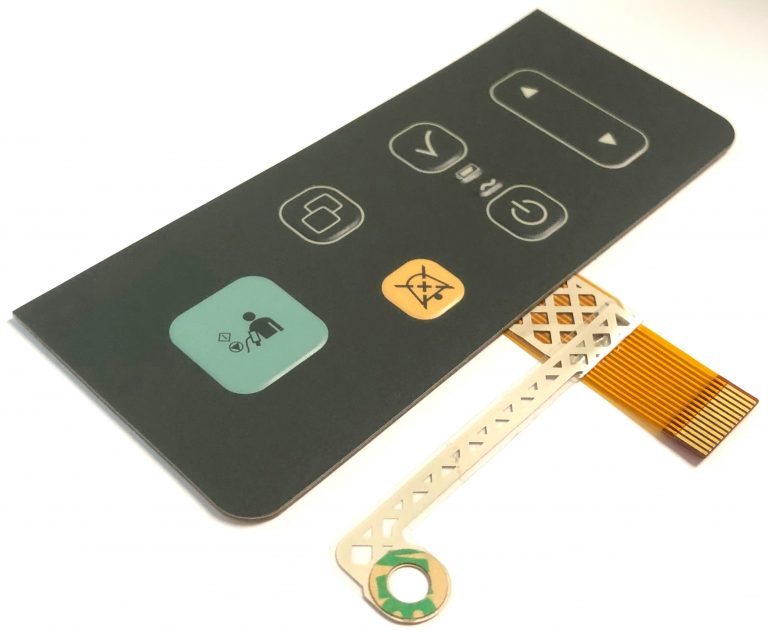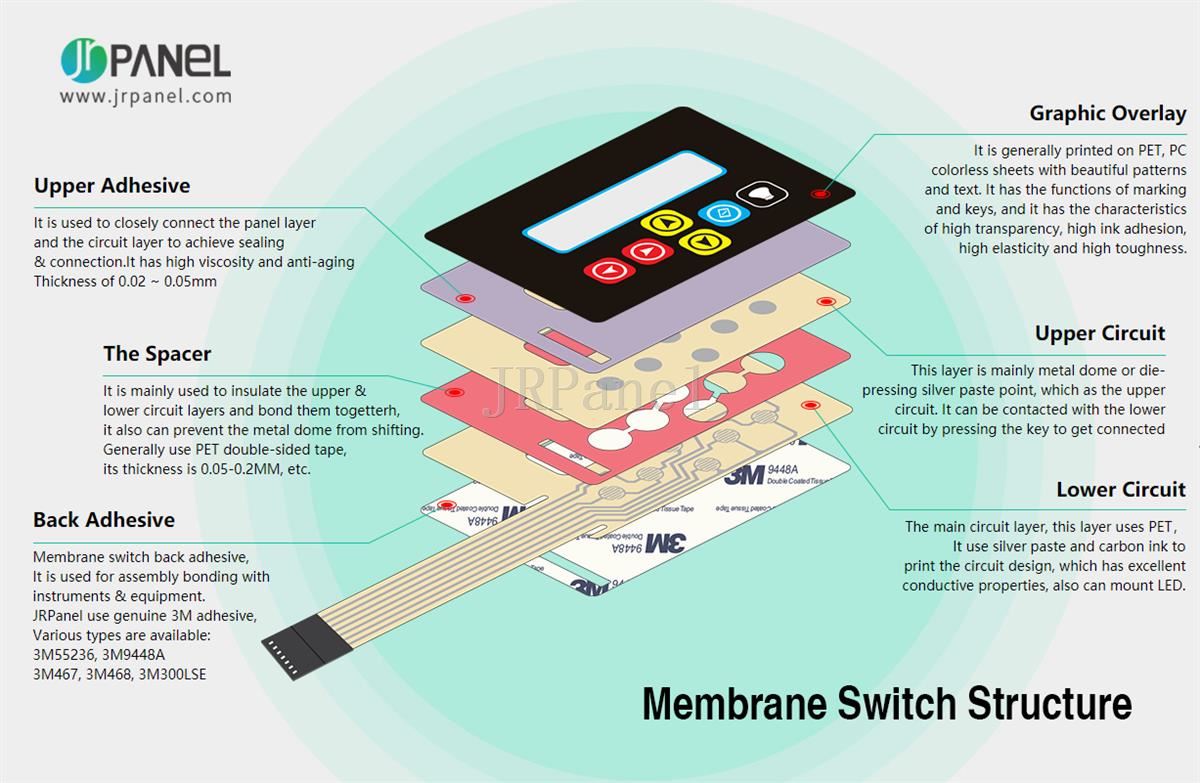Understanding the Relevance of Membrane Layer Change in Modern Electronics
Membrane layer buttons are essential elements in modern digital tools. They offer a mix of capability and design that enhances individual interaction. Their light-weight and sturdy nature makes them appropriate for different applications. As industries progress, the need for customization and progressed attributes expands. Comprehending exactly how membrane layer switches contribute to advancement discloses their relevance in shaping the future of electronic devices. What lies ahead for this modern technology?
The Essentials of Membrane Layer Change Technology
Frequently forgotten, membrane button modern technology plays an important duty in the contemporary electronic devices landscape. These tools, composed of several layers, serve as interface for numerous electronic items, varying from home appliances to clinical tools. A common membrane button includes a visuals overlay, a spacer layer, and a circuit layer, which are thoroughly constructed to create a useful interface.When stress is related to the overlay, the circuit layer is finished, allowing signals to be transferred to the gadget. This innovation is recognized for its versatility, enabling modification in layout, performance, and shape to meet certain user needs. Additionally, membrane buttons are slim and lightweight, making them appropriate for applications where space is a costs. Their toughness and resistance to ecological variables additionally boost their charm, ensuring they can stand up to rough problems while maintaining capability. Overall, membrane layer button innovation is indispensable to creating straightforward and reliable electronic gadgets

Trick Benefits of Membrane Changes
Membrane changes offer a number of vital benefits that make them a preferred choice in various digital applications. Their design enables a portable kind factor, enabling makers to produce smooth and light-weight devices. In addition, membrane buttons are immune to dust, dampness, and chemicals, which enhances their toughness and durability sought after environments. The tactile feedback offered by these buttons can improve customer experience, making them instinctive and easy to operate.Furthermore, membrane switches can be customized with varied graphics and shades, permitting distinct branding chances. The production process is generally cost-effective, especially for high-volume production, as it reduces setting up time and simplifies design. Membrane layer changes need minimal maintenance, contributing to reduced total operational prices. These advantages emphasize their growing popularity in modern-day electronics, where reliability and user-friendly interfaces are necessary.

Applications Across Numerous Industries
The convenience of membrane changes allows their widespread adoption across numerous markets. In the medical area, they are commonly used in diagnostic devices and person surveillance systems, supplying a long lasting user interface resistant to impurities. The automotive sector utilizes membrane buttons for dashboard controls, improving individual experience with sleek styles that endure severe problems. In consumer electronic devices, they work as control board for devices such as microwaves and coffee makers, giving an easy to use user interface that is simple to clean. The aerospace industry uses membrane buttons in cockpit controls, where dependability and room performance are paramount. Furthermore, the commercial sector leverages these switches in machinery and control systems to ensure durable operation in demanding atmospheres. This broad array of applications emphasizes the flexibility of membrane layer buttons, making them essential elements in boosting functionality and individual interaction across varied technical landscapes.
Customization and Design Adaptability

Future Trends in Membrane Switch Development
Arising fads in membrane layer switch growth show an expanding focus on enhanced functionality and combination with smart technologies. As consumer need for a lot more advanced digital gadgets boosts, suppliers are concentrating on producing membrane layer changes that not only serve fundamental operational roles yet likewise include features like touch level of sensitivity, backlighting, and haptic feedback.Furthermore, improvements in products are expected to boost resilience and environmental resistance, making membrane switches ideal for varied applications in industries such as medical care, auto, and consumer electronics. The integration of capacitive touch technology is likely to come to be extra common, permitting sleeker designs and enhanced individual interfaces. membrane switch.Additionally, visit homepage the rise of the Web of Things (IoT) is prompting the advancement of membrane changes that can communicate wirelessly with various other devices, boosting interconnectivity. In general, the future of membrane button technology shows up appealing, driven by development and the quest of easy to use solutions
Often Asked Questions
Just How Do Membrane Switches Over Compare to Conventional Mechanical Buttons?
Membrane layer buttons, being much more space-efficient and providing a smooth design, comparison with standard mechanical switches that supply responsive feedback. The previous usually include personalized graphics, while the last generally guarantee longevity and reliability in different applications.
What Materials Are Frequently Used in Membrane Switch Production?
Membrane switches are generally created utilizing materials such as polyester, polycarbonate, and printed conductive inks. These materials supply flexibility, responsiveness, and resilience, making them appropriate for various applications in digital tools and interface.
Can Membrane Layer Changes Be Repaired or Recycled?
Membrane switches can frequently be fixed, especially if small issues develop, such as sticky failure or surface damages. Nevertheless, complete reuse is typically restricted due to put on and potential destruction of materials in time.
Just How Do Ecological Variables Influence Membrane Layer Change Efficiency?
Ecological variables, such as humidity, direct exposure, and temperature to chemicals, greatly influence membrane switch performance. Severe problems can lead to deterioration, affecting responsiveness continue reading this and durability, eventually endangering the performance of the gadget in numerous applications.
What Is the Typical Life-span of a Membrane Layer Change?
The common life-span of a membrane layer switch generally varies from 1 to 5 million actuations, depending upon variables such as use regularity, ecological conditions, and the products utilized in manufacturing, affecting durability and performance durability. A normal membrane layer switch consists of a visuals overlay, a spacer layer, and a circuit layer, which are thoroughly put together to develop a useful interface - membrane switch.When stress is applied to the overlay, the circuit layer is completed, permitting signals to be transferred to the gadget. The responsive feedback provided by these buttons can boost user experience, making them very easy and instinctive to operate.Furthermore, membrane layer switches can be customized with varied graphics and colors, permitting for distinct branding possibilities. As consumer demand for much more sophisticated electronic tools increases, producers are focusing on developing membrane changes that not just offer fundamental functional duties however likewise incorporate functions like touch view publisher site level of sensitivity, backlighting, and haptic feedback.Furthermore, improvements in materials are anticipated to enhance sturdiness and ecological resistance, making membrane layer changes appropriate for varied applications in sectors such as health care, auto, and consumer electronics. The combination of capacitive touch innovation is likely to come to be more widespread, permitting for sleeker designs and enhanced user interfaces.Additionally, the rise of the Internet of Points (IoT) is motivating the development of membrane switches that can communicate wirelessly with various other gadgets, improving interconnectivity. Membrane switches, being extra space-efficient and supplying a sleek design, comparison with typical mechanical buttons that supply responsive responses